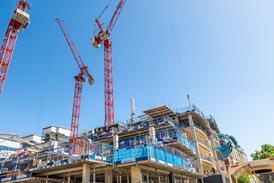Air-conditioning is the single most expensive element of engineering services. It involves not only major capital investment but also significant expenditure on maintenance, renewal and operation.
The decision to install a particular type of air-conditioning system will not necessarily be taken on lowest capital cost. Building use, facade treatment, technological innovation, environmental issues and spatial considerations will all have an impact on the choice of installation. However, the whole-life cost of the installation is rarely taken into account when choosing a system. This is surprising, given that the net present value of maintaining and operating an air-conditioning installation can be higher than the capital installation cost.
This article assesses the comparative whole-life cost performance of four of the more common air-conditioning systems used in modern commercial office schemes. These are:
For each system, the capital and whole-life costs have been calculated to show the total cost of installing the system in a new-build three-storey office development with a gross internal floor area of 6500 m2 and operating it over a 25-year period. The article assumes that the client will be eligible for tax relief on capital investment.
In some cases, there may well be sound business reasons for choosing one particular system over another. For instance, in environments where water leaks could prove catastrophic (such as dealing floors), an all-air system such as variable air volume may well be the best choice despite its high cost. Conversely, where plant and riser space is at a premium and ceiling void space is limited, then variable refrigerant flow or four-pipe fan coils may well be the only option available.
However, regardless of these factors, it is clear that to fully understand total cost commitment, whole-life cost issues must be taken into account before an air-conditioning system is chosen. The whole-life cost analysis shows that, despite the chilled ceiling installation being the second most expensive capital cost option, it is the cheapest over the 25-year life cycle. Perhaps more importantly, the cost model illustrates that the cheapest capital cost option – variable refrigerant flow – would, in this instance, prove to be the most expensive over the life-cycle term.
It is clear that whole-life cost issues should, wherever possible, be assessed in conjunction with capital cost and technical merit. Failure to do so could be a costly mistake.
Capital cost for the four systems
Standard design parameters have been adopted to maintain consistency of results across the four air-conditioning systems. The design data on which the capital cost calculations are based is generally in accordance with the British Council for Offices' Best Practice in the Specification for Offices and the Building Services Research and Information Association's rules of thumb.
Specification levels are based on an institutional standard developer Category A specification without tenant enhancements for cellular offices, meeting/conference rooms or additional cooling to computer rooms.
The capital costs shown right comprise the cost of the complete air-conditioning system, electrical supplies to mechanical plant and equipment, builder's work in connection, main contractor's preliminaries, overheads, profit and attendance, and an apportionment of professional fees. The effect of capital allowances relief expressed as net present value over the life of the installation has then been deducted to obtain the true capital cost for each system.
Whole-life costs
The whole-life cost for each option has been calculated over a 25-year period and is expressed in terms of its net present value. The life-cycle calculation for each system consists of four primary elements:
The life expectancy of individual items of plant and equipment is generally based on criteria published by the Chartered Institution of Building Services Engineers or, where available, on manufacturer's data on guaranteed life expectancy.
The discount rate used to calculate the net present value for each element of the life cycle is based on the assumption that the difference between inflation and interest rates will be about 4% at any point in time across the life-cycle period. However, it should be noted that different discount rates will affect the final results obtained from the whole-life cost calculation. Consequently, a sensitivity analysis should always be carried out in order to understand the risk associated with choosing a particular discount rate for whole-life cost calculations.
Cost analysis
In capital cost terms, the variable air volume and chilled ceiling installations are significantly more expensive than the cheapest option, variable refrigerant flow, and the fan-coil unit installation. This is mainly because of the high plant and ductwork distribution costs on the variable air volume system and the relatively high cost of the chilled ceiling elements used for the chilled ceiling and beam installation. However, when the impact of whole-life costs is taken into account, a different set of results emerges.
Over the 25 years, the chilled ceiling and beam option is by far the cheapest to maintain and operate. It is considerably less expensive than any of the other three options, and is less than half the cost of the variable refrigerant flow installation.
A system with four-pipe fan-coil units is 53% more expensive than the chilled ceilings option, the variable air volume system is 74% more expensive, and variable refrigerant flow is 111% more expensive.
The chilled ceiling and beam option is very cost-effective over the life-cycle because of its passive nature. With the exception of the main plant, there are very few moving parts to maintain and replace. The chilled elements and beams are simple cooling coils with no fans or filters, which simplifies maintenance and reduces the cost of asset replacement programmes. Also, the ceiling elements and beams have a 25-year lifespan and, unlike the other systems that need their terminal units replaced periodically, do not need to be replaced during the life of the installation.
It is also worth noting that a passive air-conditioning system such as chilled ceilings will be much less disruptive to building occupants, as the need for cleaning, filter changes and the like is minimal.
























